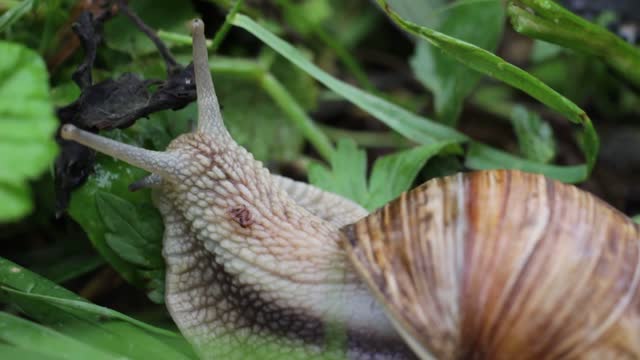Premium Only Content

Fauna Decollate Snail In Forest Grass
Facts about African Giant Snail, Garden Snail, Roman Snail or Escargot. Get Started ›
Introduction
Snails’ ancestors are one of the earliest known types of animals in the world. There is fossil evidence of primitive gastropods dating back to the late Cambrian period; this means that they lived nearly 500 million years ago.
There are many types of snails, but they fundamentally differ because they are aquatic or terrestrial. The former are adapted to live in the sea or bodies of fresh water, but the latter live exclusively on land, although in humid areas.
All land snails are gastropod mollusks, meaning that they belong to the same group of octopuses, which are part of the phylum Mollusca. At the same time, they are members of the class Gastropoda, which includes all snails and slugs. Being a mollusk means lacking an internal skeleton and bones, but snails are not unprotected.
Gastropods can adapt to a variety of living conditions, and they don’t require large amounts of food. They have been able to continually evolve to survive the conditions around them which many researchers find to be very fascinating.
Gastropods belong to the phylum Mollusca (or Mollusks) a classification of invertebrate animals with a soft unsegmented body, sometimes covered with an exoskeleton or shell. This phylum, Mollusca, includes animals like squids, octopuses, clams and cuttlefishes among others. Snails and slugs are both Gastropods. Therefore they are closely related, regardless the fact that slugs lack a protective shell.
Certainly, land snails are incredibly slow. Their forward speed depends on the species, but usually, it is between 0.5 and 0.7 inches per second. Its slowness is another feature that has made it famous, and some people have known how to play with it. For example, in many places in the UK, snail racing is organized! Can you imagine waiting for them to reach the finish line? It does not last as long as it may seem.
While moving, snails leave behind a trail of slime, a lubricant they produce to allow them to go on any terrain without injuring its body. Land Snails aren’t able to hear at all, but they have eyes and olfactory organs. They use their sense of smell to help them find food being their most important sensory organ.
You will find that snails are most active at night. They may come out during the early morning hours as well.
The biological features of snails are fascinating. For example, most are hermaphrodites, which means that a single snail has male and female reproductive organs at the same time. However, they usually mate in the “traditional” way: with a partner. A few weeks after mating and laying eggs, the hatchlings emerge from their egg, small and defenseless against many predators that sneak around, such as beetles, birds, turtles and even other snails. There are exceptions. Some species have sex differentiation, so every individual is either male or female.
The life expectancy of snails in the wild is about 3 to 7 years, but in captivity, they can live up to 10-15 years or even more.
Snail shell is made of calcium carbonate and keeps growing as long as the snail grows. They keep adding more calcium carbonate to the edge until the snail reaches adult size.
Humans have eaten land snails for centuries, although not everywhere. They are common in gastronomy, in some parts of Europe like France and Spain where they are considered a delicacy. However, their consumption must be careful, since some snails harbor parasites that, once in the human body or that of other animals, can cause severe diseases. Therefore, handling land snails, especially those found in the wild, should observe the proper hygiene precautions to avoid dangerous diseases like meningitis among others.
-
 18:14
18:14
Missouri Ozarks www.RanchViews.com
3 years ago5 Acres of Forest and Grass
1 -
 DVR
DVR
Rallied
3 hours ago $1.58 earnedSolo Challenges All Day
26.5K1 -
 LIVE
LIVE
EricJohnPizzaArtist
6 days agoAwesome Sauce PIZZA ART LIVE Ep. #59: Are You Ready for some FOOTBALL with GameOn!
71 watching -
 1:21:43
1:21:43
Jake Shields' Fight Back Podcast
8 hours agoJake Shields and Paul Miller!
13.1K42 -
 LIVE
LIVE
iCheapshot
4 hours agoCall of Duty: Black Ops Campaign
31 watching -
 4:39:16
4:39:16
Meisters of Madness
5 hours agoMadness in a Pod
1571 -
 2:25:11
2:25:11
TheSaltyCracker
2 hours agoTrump Is Not Dead ReEEeStream 8-31-25
30.3K74 -
 LIVE
LIVE
HELMETFIRE
1 hour ago🟢GAMING WITH FIRE EP9🟢
38 watching -
 1:24:08
1:24:08
Jean-Claude@BeyondMystic
12 hours ago🌀 THE WACKY WOO SHOW 3I ATLAS ALIEN INVASION with DICK ALLGIRE & JC - AUG 31 , 20254
21.2K42 -
 2:26:21
2:26:21
vivafrei
12 hours agoEp. 279: Patel's GF Sues for Defamation! Rogue Judges vs. Trump! Raja Jackson, Kick Stream & MORE!
124K65